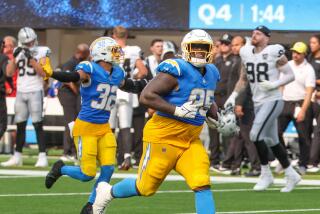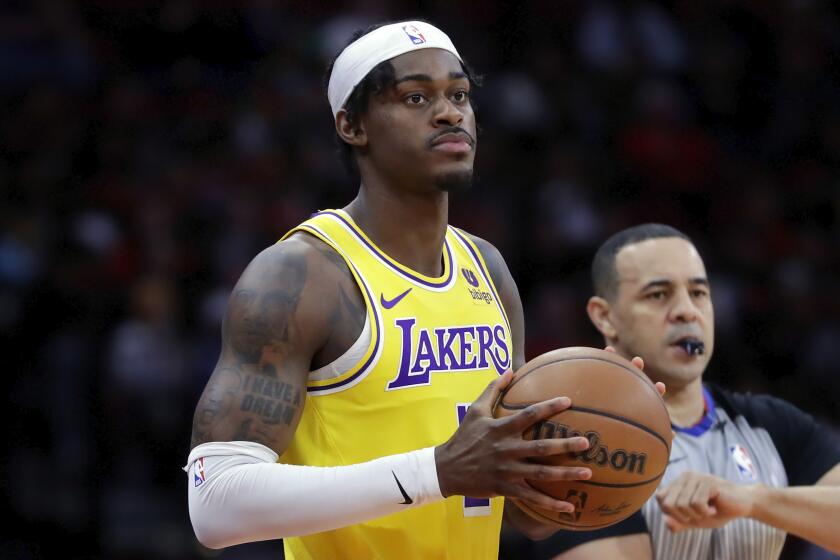NFL Clubs Lean Toward Defensive Specialists as Head Coaches
- Share via
Only a decade ago, defensive coaches in the National Football League were a lot like Dan Quayle -- fine in their place but not generally considered chief executive officer material.
“In 1979 we went to (Ray) Perkins as the head coach,” New York Giants General Manager George Young said. “He was an offensive coordinator, one of the golden boys. (Bill) Walsh, (Joe) Gibbs and later (Dan) Reeves and (Mike) Ditka were the guys people were hiring. At the time, the defensive coaches in the league did not think they had a chance of becoming head coach.
The Golden Boy Syndrome, as Young calls it, no longer prevails. Now, the league’s owners are increasingly turning their teams over to defensive wizards.
The NFL’s 28 head coaches are split; 14 are offensive specialists and 14 are defensive specialists. But of the six newcomers this season, five have a defensive resume. Three teams -- the Kansas City Chiefs, Detroit Lions and San Francisco 49ers -- made the switch from offense to defense.
Although there are prevailing circumstances surrounding most new hires (for instance, Dallas Cowboys owner Jerry Jones was the roommate of Coach Jimmy Johnson at the University of Arkansas), defense has become fashionable again in the fickle NFL.
The laundry list: Johnson, Dallas; Marty Schottenheimer, Kansas City; Wayne Fontes, Detroit; George Seifert, San Francisco; Bud Carson, Cleveland Browns; Dan Henning, San Diego Chargers. Only Henning has extensive experience on offense.
“In the NFL, we copy success and believe in reincarnation,” said Ernie Accorsi, Cleveland’s executive vice president of football operations. “That’s why so many of Vince Lombardi’s assistants were hired over the years. That’s why people are loading up on defense after the (Chicago) Bears and Giants won the Super Bowl. It’s true with players and it’s true with coaches.”
Accorsi says he interviewed seven defensive coordinators after Schottenheimer was fired over philosophical differences with owner Art Modell. With a successful quarterback, offensive coordinator and receivers coach already on board, Accorsi wanted to maintain offensive continuity.
Most team executives interviewed for this story said that offensive or defensive expertise meant less than the character of the individual coach. However, most agreed that the bias toward offense that existed early in the 1980s has subsided.
“My feeling has never changed,” Young said. “You have to run and play defense. Sure, there’s a trend there, but it comes down to the individual. There were some non-football people at the beginning of the decade who thought getting an offensive coordinator, a fancy passing game, would solve everything.
“The myth has been exploded. (Don) Shula, (Tom) Landry, (Chuck) Noll, (Weeb) Ewbank ... they all came from defense, but people forgot about it because that was a long time ago.”
In an effort to open up the game, the NFL liberalized pass-blocking rules in 1977 and 1978. The immediate result was more points. The long-term effect was a new premium on defense.
Overmatched by offenses, defenses were forced to respond. As teams began to become more aggressive through blitzing in 1983, defensive touchdowns increased sharply as offensive touchdowns began to decline.
Oddly enough, 1983 was the year two defensive coordinators were elevated to head coaching jobs by their teams, Bill Parcells with the Giants and Marion Campbell with the Philadelphia Eagles. Just after the announcements had been made following the 1982 season, the two men met at the Senior Bowl in Mobile, Ala.
“There’s a lot of pressure on us,” Campbell told Parcells. “A lot of defensive guys are looking to us. If we fail, they’ll never get hired.”
Fortunately for the Carsons and Seiferts of the world, Parcells and Campbell made generally favorable impressions. At the same time, some of the league’s defenses began to emerge as dominant.
Despite a finesse label traceable to Walsh and quarterback Joe Montana, the San Francisco team that capped the 1984 season by winning Super Bowl XIX had a ruthless defense directed by Seifert. The Chicago Bears of 1985 allowed three playoff opponents a ridiculous total of 10 points on the way to victory in Super Bowl XX. The Giants’ savage defense was a chief factor in a 17-2 season, including a victory in Super Bowl XXI.
And so, owners were not afraid to give defensive coaches a chance. Chicago defensive coordinator Buddy Ryan accepted the Eagles’ head coaching job Jan. 29, 1986, three days after his defense shredded the New England Patriots in the ultimate game. He has prospered in Philadelphia and last season gave the Eagles their first division title in eight years.
Following that 1986 season, the Houston Oilers promoted defensive coordinator Jerry Glanville and the New Orleans Saints hired Jim Mora, a successful U.S. Football League coach who once served as the Patriots’ defensive coordinator. Gene Stallings, Landry’s defensive backs coach for 14 seasons in Dallas, was the choice of the St. Louis Cardinals. Glanville and Mora, who have led their teams to the playoffs, are considered saviors in their respective areas.
This past off-season brought more turnover than usual at the top of NFL teams. Walsh and Landry retired, and Schottenheimer, Kansas City’s Frank Gansz, Detroit’s Darryl Rogers and San Diego’s Al Saunders were all fired.
“I didn’t hire Marty just because he was a defensive coach,” said Carl Peterson, Kansas City’s general manager and chief operating officer. “But you win with defense. It’s logic. If you can build a good defense, you always have a chance to win. I’ve always believed that. That’s why I hired Jim Mora for the (Philadelphia) Stars (of the USFL).”
Carson, the creative defensive coordinator of the New York Jets, was the first choice of the Browns. Accorsi was impressed with Carson’s knowledge of offense.
“He’s been defensing offenses for years,” Accorsi said. “He knows which offensive schemes give him the most trouble and how to deal with them.
“The whole idea that an offensive guy is that different from a defensive guy is the most overblown, ridiculous theory. People think they’re different sports. Look at Shula and Landry ... they were defensive guys and they were still calling the plays on the sidelines.”
Carson devotes 100 percent of his time to defense, something evident in Cleveland’s 51-0 bombing of the Pittsburgh Steelers in last week’s opener. He is content to let Marc Trestman, who tutored starter Bernie Kosar as well as Jim Kelly and Vinny Testaverde at the University of Miami, run the offense.
Fontes was the defensive coordinator under John McKay at Tampa Bay, but when he was passed over in favor of Leeman Bennett on McKay’s retirement, he joined the Lions in 1985. When Rogers was fired with five games left last season, Fontes was named interim coach. He was retained by owner William Clay Ford because he won as many games as Rogers (two) in six fewer tries.
One of Fontes’ first acts was hiring Mouse Davis, creator of the run-and-shoot offense, as his offensive coordinator. Although it is too early to call, Detroit is more likely to win games with its young defense this year.
Ten years ago, Fontes might never have gotten the chance.
“Saying that defensive guys can’t be head coaches is like saying men make better engineers than women,” Young said. “It’s only because you see more men as engineers. Now that more women are in the field that mold has been broken. That’s what’s happening with defensive coaches in the NFL.”
More to Read
Go beyond the scoreboard
Get the latest on L.A.'s teams in the daily Sports Report newsletter.
You may occasionally receive promotional content from the Los Angeles Times.










